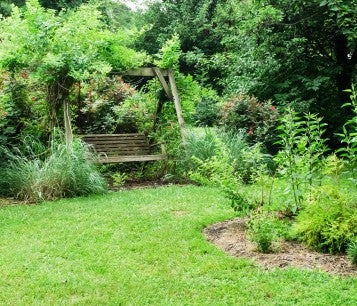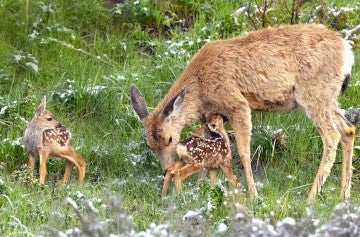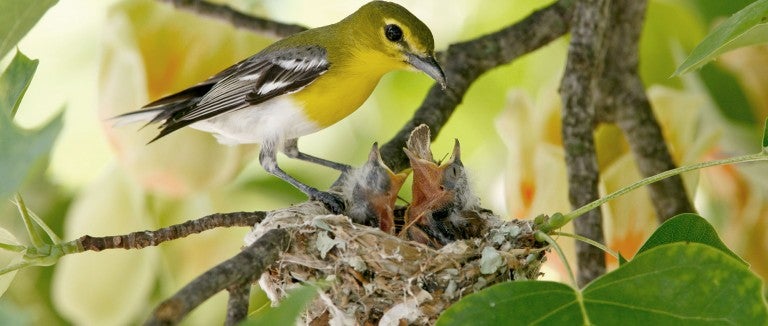Decaying logs and miniature bogs, hollowed stalks and piled rocks, nutritious pollen and leaves fallen: They’re not the stuff of traditional nursery rhymes and baby showers. But if wild mothers-to-be had gift registries, these natural supplies would top the list.
Though the basic elements for survival are plentiful enough to host young animals of all stripes (and spots and colors) in habitat-rich gardens, they can be hard to find in yards with too much turf, too few plants and a reliance on chemicals. The following tips can make any space more welcoming to wild families.
Nurture wild nurseries
Under logs, red-backed salamanders coil around eggs to ward off predators. In dying trees, baby bluebirds and raccoons peer from holes originally occupied by woodpeckers. Beneath leaves, newborn rabbits hide in nests lined with their mother’s fur. Incorporate such cozy sites into gardens by mulching with leaves, lining beds with logs and planting wildflowers around stumps harboring insects for birds and frogs.
Even DIY water sources can be a boon to aquatic amphibians, as ecologist Mark Southerland discovered after installing a prefabricated pond shell “just for the heck of it.” Though his one-third-acre yard is close to congested downtown Columbia, Maryland, spotted salamanders came to lay eggs. “I really wasn’t expecting it,” he says. “So you can create this ecosystem in a really small area.”
A humane backyard is a natural habitat offering wildlife plenty of food, water and cover, plus a safe place to live free from pesticides, chemicals, free-roaming pets, inhumane practices and other threats. And it's so easy to build!

Plant baby food
Berry- and seed-filled feeders that nourish adult birds do little for chicks: Bird babies typically eat insects, especially caterpillars, who consume mainly native plants. Adding indigenous species also expands the pantry for other animals, who derive a quarter of their nutrition from insects.
Look for “straight species,” or those that evolved naturally for millennia, rather than “cultivars,” or variants bred for human-desired characteristics. Shrubs with abnormally red leaves look pretty but may be unpalatable to caterpillars; those bred for short stature may lack spreading habits birds need for nesting. Double-petal blooms can come at the expense of pollen and nectar, and manipulated bloom periods may deny sustenance to bees emerging to build nests at specific times. Ask native plant societies and nurseries for help in finding plants beneficial to wildlife in your area.
Celebrate holes in your leaves
Once you understand that butterflies-to-be need leaves as much as we need spinach, you’ll view nibbling as cause for celebration, not consternation. Hole-punch shapes indicate the handiwork of mother leafcutter bees, who line tiny cavities in plant stalks or logs with leaf pieces, spending up to three hours creating and provisioning each nest. Support hardworking families by avoiding harmful pesticides and remembering that plants can withstand the munching; they’ve evolved defenses to thrive alongside animals for millions of years.

Don ’t mow down adolescents
Power tools imperil less visible animals at every life stage: Some adult box turtles with fractured shells have spent months recovering from their injuries at HSUS-affiliated care centers. But young turtles as small as quarters are even harder to see. Do a premowing walkabout to spot wildlife in harm’s way, or, better yet, reduce lawn areas. You’ll also protect minifauna, such as the caterpillars of fritillary butterflies, who overwinter near violets but are often obliterated by mower blades in spring. Turf alternatives can include short wildflowers mixed with native grasses and groundcovers, advises University of Illinois research scientist Jim Nardi. “You could go from a bluegrass lawn with maybe one or two [animal] species to a naturalized lawn with thousands of species,” he says.
Learn family dynamics
Human mothers pack babies into car seats, but bobcats, deer and rabbits leave young in safe spots while foraging. Bird parents watch from canopies as fledglings test their wings. Rather than assuming lone animals are orphans, watch for nearby adults, and consult with experts and online resources to prevent unnecessary bird-nappings.
Respect maternal instincts
Despite stereotypes, wild mothers aren’t “aggressive.” Who wouldn’t protect their babies when strangers approach? If you’re walking your dog near brush and a coyote appears, she may have a den nearby. Take a different route so she can raise her family in peace.
Mothers even closer to home—squirrels in chimneys or raccoons in attics—are often treated as intruders. But they’re just looking for protected nest sites. Wait until they vacate, or work with a humane wildlife service to evict them as a family unit so Mom can relocate to an alternate den. Then seal up entry points to prevent recurrence.
Want more content like this?
This was written and produced by the team behind All Animals, our award-winning magazine. Each issue is packed with inspiring stories about how we are changing the world for animals together.
Learn MoreSubscribe
